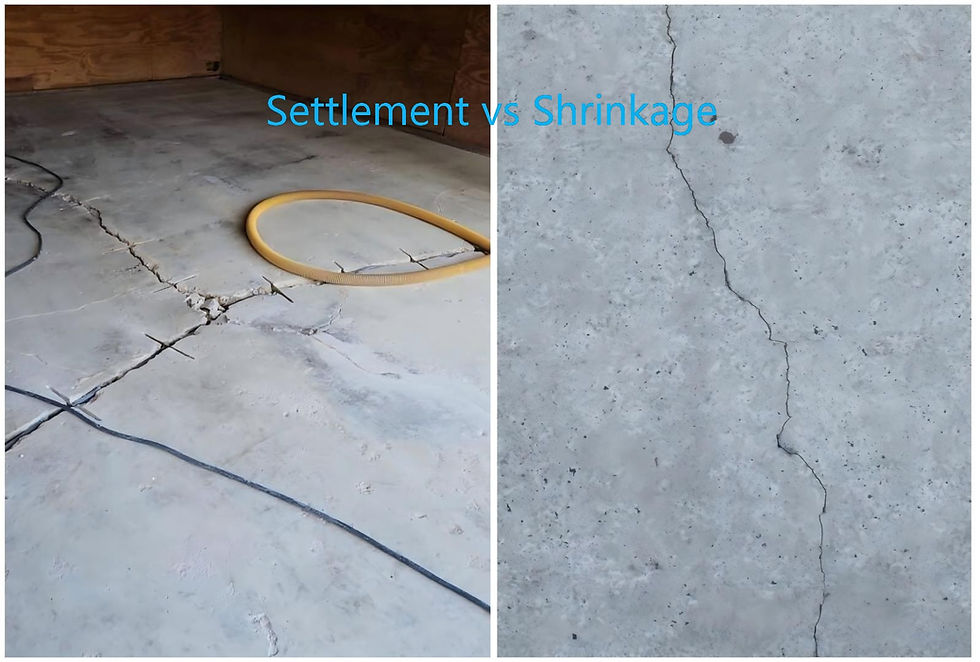Settlement Cracking vs Plastic Shrinkage: How PP Fibers Address Both
- Jason
- 4 days ago
- 3 min read
Concrete at early age is vulnerable to two major types of cracking: plastic shrinkage and plastic settlement. While they occur for different reasons, both reduce durability and long-term performance. PP fibers(polypropylene fibers for concrete) are among the most effective materials to mitigate both mechanisms.
Polypropylene (PP) microfibers are one of the most effective and widely adopted solutions for mitigating both forms of cracking. This article explains the differences between settlement and plastic shrinkage cracking, how PP fibers work, dosage recommendations, ASTM standards, and best-use scenarios.

Difference Between Settlement & Shrinkage
What Is Plastic Shrinkage?
Plastic shrinkage cracking is caused when evaporation exceeds the bleeding rate, producing rapid moisture loss at the concrete surface. As capillary pressure increases, the concrete surface enters tension before it has developed enough tensile strength, leading to random cracks.
Typical characteristics include:
Irregular, random-oriented cracks
Shallow depth (usually 2–10 mm)
Occurs within 0–4 hours
More common in hot, windy, or low-humidity conditions
This is especially common in concrete slabs, pavements, industrial floors, and shotcrete applications.
What Is Plastic Settlement?
Plastic settlement occurs when solid particles settle downward, but the presence of reinforcement, forms, or geometric changes restrains the settlement. This generates internal stresses and causes cracking directly above these restraints.
Typical features:
Cracks following steel reinforcement patterns (rebar shadow effect)
Cracks over deck corrugations, embedded items, or section transitions
Occurs within 0–2 hours after placement
Key Differences Between the Two
Type | Trigger | Timing | Appearance | Location |
Plastic Shrinkage | Rapid evaporation | 0–4 hours | Random surface cracks | Surface layer |
Settlement Cracking | Particle settlement + restraint | 0–2 hours | Cracks over reinforcement or geometry | Surface or near-surface |

PP Fiber Mechanisms for Each Crack Type
How PP Fibers Reduce Plastic Shrinkage Cracking
PP microfibers disperse throughout the concrete to create a three-dimensional micro-reinforcement network. This network limits crack initiation and crack propagation during early-age shrinkage.
Key mechanisms include:
Microcrack bridging: Fibers bridge early microcracks before they widen
Reduced free strain: Fibers limit deformation from moisture loss
Lower capillary pressure: Slower moisture transport reduces tension
Performance Data
ASTM C1579 (“Plate Test”) has repeatedly demonstrated that adding 0.9 kg/m³ of PP microfiber can reduce plastic shrinkage cracking by 70–90%.
How PP Fibers Reduce Settlement Cracking
Settlement cracking occurs internally when solids descend but reinforcement restrains that movement. PP fibers help by:
Increasing mix cohesion
Reducing bleeding channels
Enhancing particle suspension
Reducing rebar-induced settlement differentials
This makes PP fibers especially effective in slumpier mixes, precast elements, and deck slabs.

Dosage & Timing Considerations
Recommended Dosage Rates
0.6–1.0 kg/m³ — general crack control
1.0–1.5 kg/m³ — hot weather, high evaporation, or windy conditions
≥ 1.2 kg/m³ — industrial floors, pavements, and large surface areas
Timing
Since both settlement and shrinkage cracking occur within the first 1–4 hours, PP fibers must be incorporated before placement and fully dispersed in the mix.
Best Use Cases: Slabs, Mortars, and Plaster
Concrete Slabs & Industrial Floors
Slabs have high surface area and are the most susceptible to rapid moisture loss. PP fibers significantly reduce surface cracking and improve long-term abrasion resistance.
Mortar & Plaster
PP microfibers reduce surface checking, increase cohesion, and minimize sagging or slumping.
Precast Elements
Settlement cracking is especially common in precast forms. PP fibers increase green strength and uniformity during vibration, transport, and demolding.

Testing Standards (ASTM C1579, C1116)
PP fibers are evaluated under several international standards:
ASTM C1579 — Plastic shrinkage cracking test
ASTM C1116 — Standard for fiber-reinforced concrete
EN 14889-2 — European classification for polymer fibers
ACI 544 — Guide for design and application of fiber-reinforced concrete
PP microfibers consistently demonstrate:
✔ Significant reduction in plastic shrinkage cracking
✔ Improved early-age cohesion
✔ Better resistance to settlement cracking
✔ Enhanced durability as secondary reinforcement
Learn more about HPM® PP polypropylene microfiber
See all micro synthetic fiber types
Compare with macro synthetic fibers





Comments